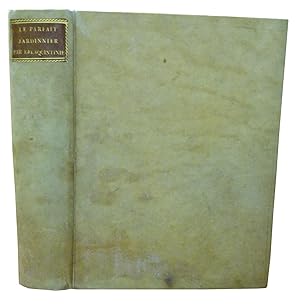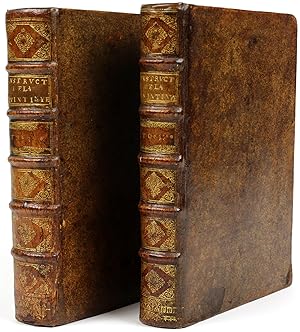Quintinye Quintinie Jean (5 results)
Product Type
- All Product Types
- Books (5)
- Magazines & Periodicals
- Comics
- Sheet Music
- Art, Prints & Posters
- Photographs
- Maps
-
Manuscripts &
Paper Collectibles
Condition
- All Conditions
- New
- Used
Binding
- All Bindings
- Hardcover
- Softcover
Collectible Attributes
- First Edition (1)
- Signed
- Dust Jacket
- Seller-Supplied Images (4)
- Not Printed On Demand
Seller Location
Seller Rating
-
The Complete Gard'ner or Directions for Cultivating and Right Ordering of Fruit-Gardens and Kitchen-Gardens. With the Gardener's Kallender, Directing What is to be Done Every Month in the Year. [Gardener Calendar]
Published by London, A and W. Bell, 1717. Sixth edition, corrected. *, 1717
Seller: Travis & Emery Music Bookshop ABA, London, United Kingdom
Title continues "Now Compendiously Abridg'd, and Made of More Use, with Very Considerable Improvements. By George London, and Henry Wise. To which is prefix'd, an Address to the Nobility and Gentry. By J. Evelyn, Esq." 12mo (19 x 11cm). xxxvi, 325, [vii] pages. Original full leather, very worn and bumped, joints and hinges cracked but cords holding. Backstrip with raised bands, beginning to perish. 9 folding plates at pages 102, 114-122, 130, 154 and 164. Tiny plate at page 27. No frontis.
-
LE PARFAIT JARDINIER OU INSTRUCTION POUR LES JARDINS FRUITIERS ET POTAGERS. Avec un traité des ORANGERS, suivi de réflexions sur l'AGRICULTURE.
Seller: Librairie de l'Univers, Lausanne, Switzerland
Paris, Claude Barbin, 1695. 22x29 cm. Ouvrage en 2 tomes et 2 suppléments reliés en 1 volume. 316+319+68+140+2 pages. Portrait de l'auteur en frontispice et 5 petites gravures en tête des diverses introductions. Reliure en plein parchemin, peut-être postérieure à l'ouvrage. Dos lisse portant le titre et le nom de l'auteur sur une pièce de peau de couleur orangée. Pages 297 à 304 en blanc (défaut d'impression ?). Quelques minimes et rares rousseurs pâles sans gravité, sinon ouvrage propre et de présentation agréable.
-
Instruction pour les jardins fruitiers et potagers: plus un traité des Orangers et des reflexions sur l'Agriculture; avec une instruction pour la Culture del fleurs
Published by Chez Charles Osmont, ruë Saint Jacques, à l'Ecu de France, A Paris, 1716
Full Calf. Condition: Fine. Early Reprint. New, revised and enlarged edition (Augmentée de la Culture des Melons, de la maniere de taillerles Arbres Friutiers, d'in Dictionnaire des termes dont fe fervent les Jardiniers en parlant des Arbres, & d'une Table des Matieres), of the most famous French manual on gardening. Complete in two quarto volumes. [8],16,23[i. e., 32],[8],666[84 misnumbered 80],[4], with 12 copper-engraved plates (2 folding), mostly of pruning patterns and tools; [12],562,[30]pp, with one plate and woodcuts in text of both volumes. Each section (six main books on fruit and kitchen gardens, treatise on oranges and reflection on agriculture) begins with a large engraved vignette and historiated initial. Contemporary speckled calf, spine richly gilt in six compartments between raised bands, brown morocco lettering piece gilt, edges speckled red, plain period end papers, title page with woodcut vignette. A superb set, occasional toning, very sporadically scattered marginal foxing, else a beautifully printed, clean, crisp wide-margined copy in handsome period binding. Brunet III 838. Hunt 388. Oak Spring Pomona 1. Pritzel 5075. Originally published (posthumously) in Paris, in 1690. Probably the most influential book in the history of pomology, by the leading French gardener of the seventeenth century. For more than 20 years, beginning in 1665, La Quintinie worked as gardener to Louis XIV, rising steadily with ever-expanding titles. The potager at Versailles, constructed from 1677 to 1683, is the most famous of the fruit and kitchen gardens he oversaw in all the royal houses to meet the needs of the court: asparagus in December and strawberries in April, as well as the King's favorite figs. This book, published by La Quintinie's son Michel, introduced his methods to a wide audience, with detailed instructions for planting, pruning and espaliering fruit trees, and cultivating vegetables. Later editions, such as our copy, added to the directions for pruning and thinning out buds sections on melons and flowers, as well as advice on dealing with orange tress and La Quintinie's reflection on agriculture. N. B. With few exceptions (always identified), we only stock books in exceptional condition. All orders are packaged with care and posted promptly. Satisfaction guaranteed.
-
THE COMPLEAT GARD'NER (GARDENER), or Directions for Cultivating and Right Ordering of FRUIT GARDENS and KITCHEN GARDENS;
Published by London printed for Matthew Gillyflower at the Spread Eagle in Westminster-Hall and James Partridge at the Posthouse at Charing-Cross M DC XC III, 1693
First Edition
TITLE CONTINUED: With Divers REFLECTIONS on several Parts of HUSBANDRY. In Six BOOKS. By the Famous Monsr. De La Quintinye, Chief Director of all the GARDENS of the French-King. To which is added His Treatise of ORANGE-TREES, with the Raising of MELONS, omitted in the French Editions. Made English by JOHN EVELYN Esquire, illustrated with Copper Plates. FIRST EDITION 1693. Folio, approximately 320 x 195 mm, 12¾ x 7¾ inches, engraved portrait of author by W. Elder, plus 11 engraved plates, 2 are double page, 8 engraved headpieces, showing various garden activities, 7 small text illustrations, title page printed red and black, engraved bookplate of Jacob Des Bouverie Esq., on verso title page, silk bookmark still present. pages: [44], 1-184, (leaves 107-111 and 115-119 numbered on recto only, leaf 118 misnumbered 116), [4], 1-116, 137-204, [4], 1-4, 1-80, a jump in text from 116-137 but all text complete, the same numbering in all copies (see ESTC R212118), bound in contemporary calf and rebacked in a lighter leather, gilt lettered spine, original endpapers retained. Old calf covers rubbed with shelf wear to edges, corners worn with board showing at tips, small pale stain at top of portrait and title page, pale staining to margins of portrait, hole to page 138 due to old ink spot with loss, affecting 4 words, small rust hole affecting 3 small words, all easily legible, other occasional small ink spots, pale browning to margins, age-browning to page 59-62 in the Reflections upon some Parts of Agriculture and 3 old ink corrections on 1 text page, original printed words crossed through (possibly by John Evelyn?), 2 leaves have tips of lower corners missing, not near text, a few shallow creases in places, otherwise a very good copy. First (and only unabridged) English edition, originally published in Paris in 1690. La Quintinie worked as gardener for Louis XIV. He visited England, where he met John Evelyn and visited his garden at Sayes Court, "Monsieur de la Quintinye, being in England, that receiving the Honor of a visit from him at my house, and falling into discourse of Gardens, on my request sent me some directions concerning the Ordering of Melons". See: H. Frederic Janson, Pomonas Harvest, page 124 and following 2 illustrations; Blanche Henrey, British Botanical and Horticultural Literature, Volume 1, page 243; Rachel McMasters Miller Hunt, Catalogue of Botanical Books, page 406-407 No. 388; Geoffrey Keynes, John Evelyn, A Study in Bibliophily, pages 224-226; Stanley Johnston, The Cleveland Herbal, Botanical and Horticultural Collections, page 266, No. 293; Sandra Raphael, An Oak Spring POMONA, A Selection of the Rare Books on Fruit in the Oak Spring Garden Library, Volume 2, page 11; Mary Aslin Catalogue of the Printed Books on Agriculture, page 307; Philosophical Transactions 1669, pages 901-903, La Quintinye On Melons. MORE IMAGES ATTACHED TO THIS LISTING, ALL ZOOMABLE, FURTHER IMAGES ON REQUEST. POSTAGE AT COST.
-
Couverture rigide. Condition: Bon. 2 vol., [8] pp., portrait, Paris, chez Claude Barbin, 1690, in-4, 2 vol, [8] pp, portrait, 16-522-[2] pp. + 566-[2] pp, 13 pl, Veau marbré, dos lisses et ornés, refaits à l'imitation, pièce de titre rouge et tomaison havane, Édition originale, très rare, de ce célèbre ouvrage sur la culture des arbres fruitiers. L'illustration se compose de : 8 bandeaux représentant des jardiniers au travail, placés en tête des six parties de l'Instruction, du Traité de la culture des orangers et des Réflexions sur l'agriculture ; du portrait de l'auteur en frontispice ; d'1 planche à double page représentant le potager du roi à Versailles ; 1 autre planche double montrant les manières de préparer un arbre pour le planter ; 3 planches d'outils (serpettes, scies, greffoir) ; et 8 planches matérialisant la taille d'arbres en fonction de leur nombre de branches et de leur âge. Jean-Baptiste de la Quintinie (1626-1688), fameux jardinier et agronome français, a rassemblé toute son expérience et livré ses toutes ses réflexions dans cette Instruction, qui lui assura une immense gloire posthume. L'ouvrage se démarque des autres traités agricoles de son temps par la méthode rationnelle qu'il propose, par son éloquence et par son inclination scientifique ; il s'imposa, en quelques décennies, comme une référence dans le domaine de la culture des arbres fruitiers et connut une traduction anglaise dès 1693, ainsi que de nombreuses contrefaçons. La Quintinie abandonna la profession d'avocat pour se consacrer à l'art des jardins ; il s'occupa de ceux des grands personnages de l'époque (Nicolas Fouquet, le prince de Condé, le duc de Montausier, Colbert). En 1670 Louis XIV le chargea de la direction de ses jardins fruitiers et potagers. Ensuite, pour cinq années, il se consacra à la création du nouveau potager du roi. On doit à ce jardinier du Grand Siècle d'avoir enrichi l'horticulture "des apports de la physiologie végétale, de la botanique et des premiers rudiments de la chimie" (Martine Constans, Jardiner à Paris au temps des rois, 2003). Il contribua également à la distinction entre les divers métiers spécialisés dans la création de jardin : jardiniers, fleuristes, botanistes, maréchais, etc. Ex-libris manuscrit non identifié et ex-libris manuscrit "Buous" à la page 3 de la quatrième partie. Bon exemplaire. Reliures restaurées et dos refaits. Quelques feuillets uniformément brunis, décharges, petites taches d'encre sur les tranches. Pritzel 5075.






